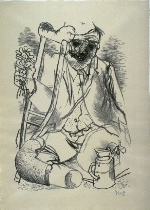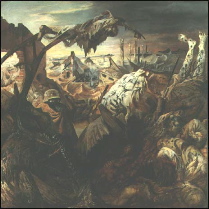
I was reading Paul Johnson’s “Art: A New History” last night, a rather iconoclastic work as it turns out. Johnson is not an art historian but an journalist and art reviewer and he comes at it as a populist with a passion for art (his father was a painter as is he).
Johnson’s dismissive of a whole bunch of 20th century artists, including Picasso and Matisse. He rounds up all the isms–dada, surreal, future, cube, fauve) and summarily executes them as “fashion art.” Flavor of the week, he means, and too swayed by market forces and by fashion.
He makes a distinction between fashion art and what he calls the “pure” abstract art of Paul Klee and Kandinsky which he thinks has merit.
Predictably, he likes figurative art and gives points to David Hockney, Edward Hopper, Andrew Wyeth (I said he was a populist) and Norman Rockwell whom he calls “a Dutch genre painter transmuted into 20th century America.”

Which brings me to George Grosz and Otto Dix. Johnson says George Grosz, whom he dubs “the gifted German line artist,” helped start a new movement called the New Objectivity or Neue Sachlichkeit which sprang up out of a rejection of modern art’s isms.
This new movement was to tell it like it was. And Grosz and Dix (who was also in the movement) working at a time of war and corruption did just so.
Anyway, I just want to add Grosz and Dix to the discussion as artists dealing with real things as opposed to Currin, who, as Franklin says, is dealing with art — and doing it very fashionably.
(image, top is Grosz’s lithograph “The Hero,” image, right is Dix’s “Trench Warfare”)









